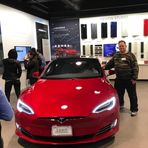The Electric Future: Navigating the Crossroads of Tesla and Politics
March 12, 2025, 4:16 pm

Location: United States, Texas, Austin
Employees: 10001+
Founded date: 2003
Total raised: $3.86B

Location: United States, California, Mountain View
Employees: 1001-5000
Founded date: 2009
Total raised: $19.17B
The electric vehicle (EV) landscape is shifting. At the center of this transformation is Tesla, the giant that has redefined the automotive industry. Yet, as political winds change, so too does the future of this pioneering company. Elon Musk’s close ties to Donald Trump have sparked debate. Will this relationship propel Tesla forward or drag it down?
Tesla is not just a car manufacturer; it’s a symbol of innovation. It has led the charge in the EV revolution, turning heads and changing minds. But now, the road ahead is riddled with potholes. The Trump administration’s policies threaten to reshape the EV market. The stakes are high, and the implications are profound.
Musk’s support for Trump has drawn mixed reactions. Some see it as a strategic move, a way to influence regulations that could benefit Tesla. Others view it as a liability, a potential anchor that could sink the company. The truth lies somewhere in between.
The EV market is not just about cars; it’s about policy. The Trump administration has signaled a shift away from pro-EV regulations. An executive order aims to eliminate subsidies that have supported the growth of electric vehicles. This could mean a loss of the $7,500 federal tax credit for Tesla buyers. Suddenly, the price of a Tesla could rise by that same amount. For many potential buyers, that’s a deal-breaker.
Tesla has thrived on government credits. In 2024, the company raked in over $2.7 billion from selling regulatory credits to other automakers. This revenue stream has been crucial for Tesla, helping to bolster its bottom line. But if these credits vanish, the financial landscape changes dramatically. Analysts warn that without these credits, Tesla’s free cash flow could turn negative.
The competition is heating up. Rivals are emerging, eager to carve out their share of the EV market. Companies like Ford and General Motors are ramping up their electric offerings. They are not just playing catch-up; they are investing heavily in technology and infrastructure. As these competitors gain traction, Tesla’s market dominance could be threatened.
Yet, some analysts remain optimistic. They argue that Tesla’s scale and efficiency give it an edge. The company can afford to cut prices and incentivize sales, making it harder for smaller competitors to survive. In a market where profit margins are thin, Tesla’s ability to adapt could be its saving grace.
Musk’s vision extends beyond cars. He sees Tesla as a leader in autonomous driving and robotics. This perspective shifts the narrative. Tesla is not merely an automobile company; it’s a tech company at heart. The future lies in self-driving vehicles and smart technology. If the regulatory environment becomes favorable for autonomous vehicles, Tesla could thrive.
However, the road to autonomy is fraught with challenges. Critics point to the current limitations of Tesla’s self-driving technology. Many users report disengaging the autopilot feature frequently. The technology is not yet foolproof. This raises questions about consumer confidence and market demand.
In Europe, Tesla faces additional hurdles. Sales have plummeted in key markets, with reports of a 60% drop in Germany. This decline signals a shift in consumer preferences and growing competition. The European market is becoming increasingly saturated with EV options. Tesla must adapt or risk losing its foothold.
The political landscape adds another layer of complexity. Musk’s association with Trump could alienate some consumers. Public perception matters. If consumers view Tesla as a political pawn, they may turn to competitors. The brand’s image is crucial in a market where loyalty can be fleeting.
Moreover, the administration’s stance on EV charging infrastructure poses a threat. Tesla has benefited from federal funding to expand its charging network. A pause on these funds could slow growth and limit accessibility for potential buyers. Charging infrastructure is vital for the widespread adoption of EVs. Without it, the market could stagnate.
Looking ahead, the future of Tesla hinges on adaptability. The company must navigate a landscape marked by political uncertainty and fierce competition. It needs to innovate while maintaining its brand identity. The balance between technological advancement and public perception will be critical.
As the EV market evolves, Tesla stands at a crossroads. The company has the potential to lead the charge into a sustainable future. But it must overcome obstacles both internal and external. The relationship between Musk and Trump could be a double-edged sword. It may open doors or close them.
In the end, the electric vehicle revolution is not just about technology; it’s about vision. Tesla has the opportunity to shape the future of transportation. But it must do so with a keen awareness of the political and economic currents at play. The road ahead is uncertain, but one thing is clear: the journey is just beginning.
In this rapidly changing landscape, Tesla must remain agile. It must harness its strengths while addressing its weaknesses. The future of the company—and the EV market—depends on it. As we watch this story unfold, one question remains: will Tesla continue to lead, or will it be left in the dust?
Tesla is not just a car manufacturer; it’s a symbol of innovation. It has led the charge in the EV revolution, turning heads and changing minds. But now, the road ahead is riddled with potholes. The Trump administration’s policies threaten to reshape the EV market. The stakes are high, and the implications are profound.
Musk’s support for Trump has drawn mixed reactions. Some see it as a strategic move, a way to influence regulations that could benefit Tesla. Others view it as a liability, a potential anchor that could sink the company. The truth lies somewhere in between.
The EV market is not just about cars; it’s about policy. The Trump administration has signaled a shift away from pro-EV regulations. An executive order aims to eliminate subsidies that have supported the growth of electric vehicles. This could mean a loss of the $7,500 federal tax credit for Tesla buyers. Suddenly, the price of a Tesla could rise by that same amount. For many potential buyers, that’s a deal-breaker.
Tesla has thrived on government credits. In 2024, the company raked in over $2.7 billion from selling regulatory credits to other automakers. This revenue stream has been crucial for Tesla, helping to bolster its bottom line. But if these credits vanish, the financial landscape changes dramatically. Analysts warn that without these credits, Tesla’s free cash flow could turn negative.
The competition is heating up. Rivals are emerging, eager to carve out their share of the EV market. Companies like Ford and General Motors are ramping up their electric offerings. They are not just playing catch-up; they are investing heavily in technology and infrastructure. As these competitors gain traction, Tesla’s market dominance could be threatened.
Yet, some analysts remain optimistic. They argue that Tesla’s scale and efficiency give it an edge. The company can afford to cut prices and incentivize sales, making it harder for smaller competitors to survive. In a market where profit margins are thin, Tesla’s ability to adapt could be its saving grace.
Musk’s vision extends beyond cars. He sees Tesla as a leader in autonomous driving and robotics. This perspective shifts the narrative. Tesla is not merely an automobile company; it’s a tech company at heart. The future lies in self-driving vehicles and smart technology. If the regulatory environment becomes favorable for autonomous vehicles, Tesla could thrive.
However, the road to autonomy is fraught with challenges. Critics point to the current limitations of Tesla’s self-driving technology. Many users report disengaging the autopilot feature frequently. The technology is not yet foolproof. This raises questions about consumer confidence and market demand.
In Europe, Tesla faces additional hurdles. Sales have plummeted in key markets, with reports of a 60% drop in Germany. This decline signals a shift in consumer preferences and growing competition. The European market is becoming increasingly saturated with EV options. Tesla must adapt or risk losing its foothold.
The political landscape adds another layer of complexity. Musk’s association with Trump could alienate some consumers. Public perception matters. If consumers view Tesla as a political pawn, they may turn to competitors. The brand’s image is crucial in a market where loyalty can be fleeting.
Moreover, the administration’s stance on EV charging infrastructure poses a threat. Tesla has benefited from federal funding to expand its charging network. A pause on these funds could slow growth and limit accessibility for potential buyers. Charging infrastructure is vital for the widespread adoption of EVs. Without it, the market could stagnate.
Looking ahead, the future of Tesla hinges on adaptability. The company must navigate a landscape marked by political uncertainty and fierce competition. It needs to innovate while maintaining its brand identity. The balance between technological advancement and public perception will be critical.
As the EV market evolves, Tesla stands at a crossroads. The company has the potential to lead the charge into a sustainable future. But it must overcome obstacles both internal and external. The relationship between Musk and Trump could be a double-edged sword. It may open doors or close them.
In the end, the electric vehicle revolution is not just about technology; it’s about vision. Tesla has the opportunity to shape the future of transportation. But it must do so with a keen awareness of the political and economic currents at play. The road ahead is uncertain, but one thing is clear: the journey is just beginning.
In this rapidly changing landscape, Tesla must remain agile. It must harness its strengths while addressing its weaknesses. The future of the company—and the EV market—depends on it. As we watch this story unfold, one question remains: will Tesla continue to lead, or will it be left in the dust?